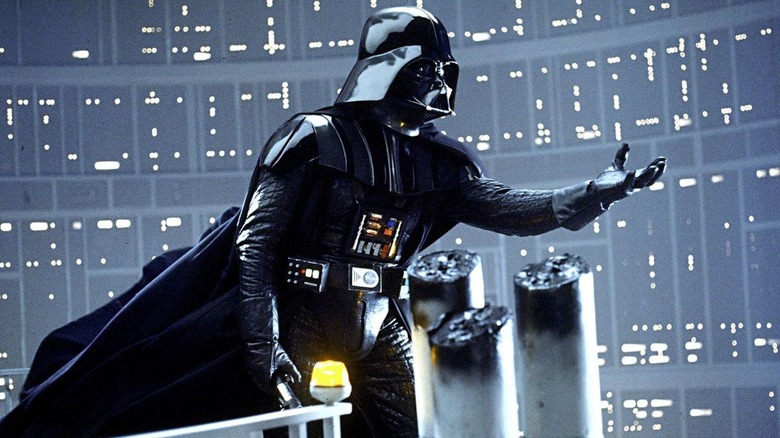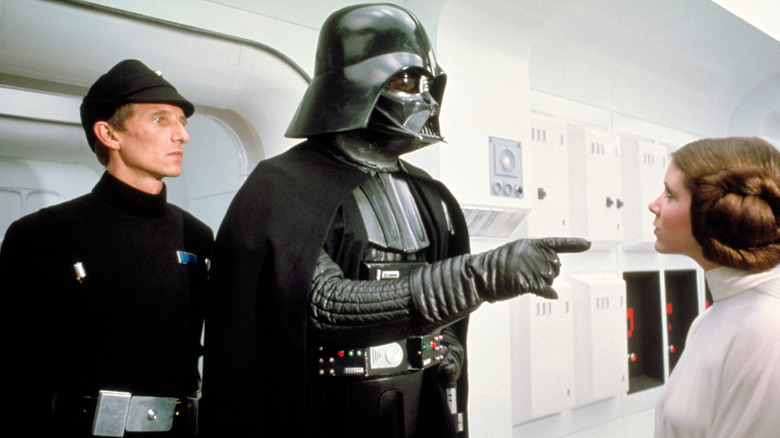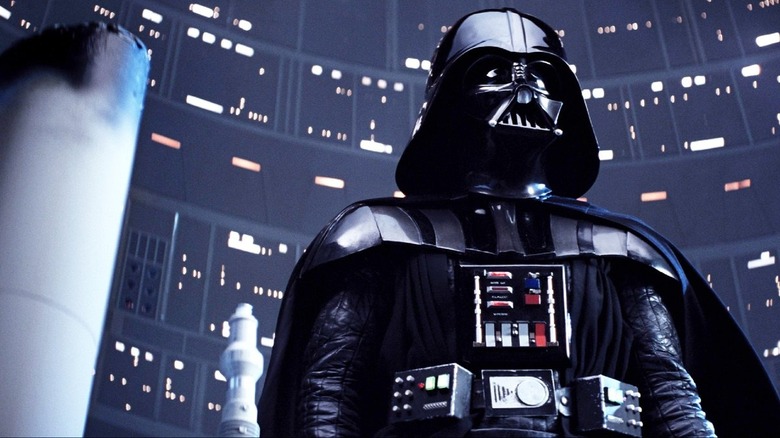How Darth Vader's Costume Took Inspiration From Bikers, Nazis, And World War I
Did you know that John Mollo, the costume designer for "Star Wars: A New Hope," had never had any costume design experience before landing that gig? It's kind of amazing when you consider just how iconic and influential the look of all the outfits in "Star Wars" have become. What got him the job was his expertise in historical military costumes, which was of great interest to George Lucas. He wanted someone who was fluent in real-world costumes, not a Hollywood costume designer who had experience in science fiction. For Lucas, "Star Wars" only worked if we recognized enough of our world in it to help ease the audience into the sci-fi/fantasy of it all.
Obviously, Mollo didn't work on these striking costumes himself. He had a dedicated team and was working off of not only George Lucas's script descriptions but also Ralph McQuarrie's production art. That said, Mollo still had to make those real, and in order to do that he had to get very creative with all the looks in the movie, but there was one that was absolutely crucial to get right above all others and that was the film's heavy; a little Sith Lord named Darth Vader. You might have heard of him.
From David Lean to WW2
Before Mollo was hired, McQuarrie and Lucas came up with a Darth Vader design heavily inspired by Japanese samurai with a dash of David Lean's epic desert-based masterpiece "Lawrence of Arabia." Lucas wanted his villain to have a "fluttering" look that he described as "a dark lord riding on the wind," which is the "Lawrence of Arabia" connection as the original idea was to dress him in a silky, black outfit. This would later evolve into Vader's iconic cape.
Vader was also supposed to wear a sort of Japanese kabuto, which is a samurai warrior's helmet, and McQuarrie thought it would be cool to throw in a samurai face mask (known as a mempo) as well. That ended up evolving into a breathing device, which was an idea once again put forth by McQuarrie. He noticed that Vader's introduction was him moving from one ship to another and thought it would make sense that Vader would need something to help him breathe during that transition. Lucas dug this idea so much that he wanted it to be a permanent part of Vader's look.
Keep in mind, this is before Anakin Skywalker's backstory was put in place, and Lucas would end up folding that into Vader's backstory.
When Mollo started seeing McQuarrie's artwork, he immediately noticed the similarities between Vader's outfit and the look of the German soldiers in both WW1 and WW2. The suit reminded him of trench pieces worn by the Germans in WW1 and he knew the helmet top had to be fashioned after the Nazi combat helmet.
Adding depth to the darkness
Ultimately, Mollo would use that Nazi combat helmet and a WW1-era gas mask as the most direct inspiration for Vader's helmet and would construct the rest of the outfit out of a black motorcycle suit and a Monk's cloak they found in the costumer's Middle Ages department.
Of course, a lot of customization went into the final screen look; it wasn't just those disparate pieces cobbled together, but they were what got Lucas to sign off on what would become the iconic Darth Vader. The final helmet was sculpted off of David Prowse's lifecast to ensure a perfect fit and was ultimately cast in fiberglass, which is the version we see in the films.
As for the rest of Vader's duds, the biggest challenge for Mollo and his team was creating something that didn't just appear as a black void on camera. So you get a chest plate with a bunch of lights and that striking two-tone gray and shiny black shoulder armor. The same treatment was done on the mask, which gives it both a shine and a depth to the darkness.
Darth Vader's final look in the "Star Wars" movies is a perfect example of the creativity of a group of people "yes and-ing" an initial idea into something that will be remembered for decades to come.


